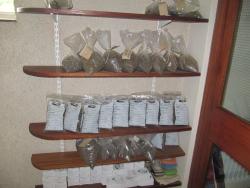 If you’ve ever grown peas at home you will know how wonderful freshly picked peas from the garden can be. The only problem is that they need to be planted in industrial quantities to get a decent crop. In my own experience a single home grown crop only lasts one meal. Rubbish eh?
If you’ve ever grown peas at home you will know how wonderful freshly picked peas from the garden can be. The only problem is that they need to be planted in industrial quantities to get a decent crop. In my own experience a single home grown crop only lasts one meal. Rubbish eh?
So when Christopher Day (@themanorhousebb) invited me to see the Lincolnshire pea harvest in action boy did I get excited:). On a dank drizzly Sunday we turned off the A15 and drove down a track looking for pea viners.
The Green Pea Company Ltd had 3 machines working fields near Hibbaldstow in Lincolnshire where the harvest is in full swing – keeping the nation fed. Where would our fish and chips be without peas? This is vital work.
There was a mobile workshop in the corner of the field and we stopped there to talk to the vining team. Once it has begun the pea harvest continues 24 hours a day for two months. Teams work 12 hour day/night shifts on a 2 week rotation. After donning a fluorescent safety jacket I got a ride with Glen.
The cabs are not as high tech as the Quadtrac but that is quite possibly a personal choice of the owner of the kit. All the driver has to do is steer though. Everything else is automated. Harvesting rate, weight in the tank – all controlled by computer.
Pea pods are “bashed” by metal tines under the viner and are effectively sucked into the belly of the machine where the casings are mechanically removed and the peas “popped” into one of two storage tanks. When the peas are offloaded to an external tractor-towed hopper they start with the most recently filled tank so that the “older” peas remain near the top when taken to processing. That hopper is taken to a bigger lorry which transports the peas back to the factory, in this case near Hull.
The viners are pricey – at £300k a pop they re even more expensive than the Quadtrac. With three of them on a job plus the other kit we are looking at a million pounds worth of cash driving around the field. They are also not as wide because the whole vehicle needs to be able to travel on the public highway without having to unbolt the front mechanism so they can’t process as much acreage as a Quadtrac. The average speed depends on many factors – weight of peas on the vine, ground conditions and instructions from the Birds Eye factory on how much tonnage they need at any given point in time. A typical average over the whole season is around a hectare per hour per machine.
Peas must have been a luxury item in the “old days”. No machines then, just men with scythes and teams of workers picking the pods off the vine. Expensive to harvest plus in my mind likely to have more losses due to the imprecise nature of the scything.
Today each machine weighs 27 tons and can carry 2 tonnes of peas. That’s heavy man. If you happen to find yourself stuck behind a convoy of viners consider yourself unlucky. They travel at 25kmh. With a convoy of 3 viners, a tractor towing a hopper, water and diesel trailers together with outrider vehicles overtaking is going to be a problem but hey… what price peas?
The teams work to specific instructions from Birds Eye who also send testers1 into fields beforehand to test the peas for quality & readiness to pick. Birds Eye even tell them how much weight of peas to store in the tank before tipping into the hopper.
All so that I can enjoy my steak and chips (and fish and burger and sausage and chicken and veggieburger etc etc 🙂 )
The Green Pea Company harvests thousands of tonnes of peas in a season using 15 viners. I went away with two carrier bags full as a memento of my time there. Thanks to farmer Christopher Day, The Green Pea company, Birds Eye and finally to Glen for letting me drive around the field in the viner with him.
They are big boys toys – quadtracks and viners. The question is where do I go from here?
1A lot of testing goes on in the farming business. The two photos below show Christopher Day’s soil samples and testing kit. The days of the bumpkin farmer with a long piece of straw between his teeth and a straw hat are gone. The complexity of the business is such that you need qualifications and certificates to grow stuff these days.

